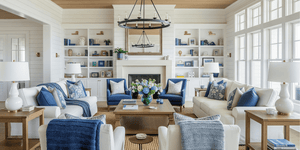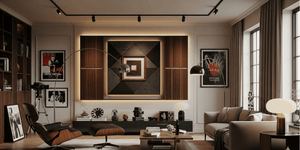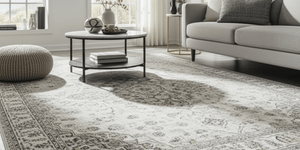Top Tips for Creating the Perfect Home Theater Room
A home movie theater room is an amazing entertaining space that provides the classic theater experience. Movie rooms allow you to spend time with your family and friends while binge-watching your favorite movies and catching up with your favorite TV show characters. When you top it off with lighting controls and quality surround sound, you have the perfect atmosphere for your viewing pleasure.
As far as DIY projects go, designing a DIY home theater could be one of the most rewarding updates you could complete in your home. If done well, it may quickly become one of your favorite spots in the house. So where do you start? In this article, we will give you some tips on how to DIY the perfect home theater room. Let's dive in!
Start by Picking the Room
While many of us watch movies in our living room, a dedicated home theater should be located in a room 20 feet long by 13 feet broad and secluded from the other areas of the home. It should be situated where it does not interfere with daily activities within the house. After all, you don't want the subwoofer speakers’ noise to annoy everyone and cause frequent complaints.
If your home has an attic, it can make for the perfect place to set up your home theater. You can easily fit a projector screen, surround sound cables, and acoustic panels for soundproofing to improve your viewing experience. Alternatively, you can revamp your basement into a media room. Not only is it isolated from other living spaces, but there are frequently few or no windows, making it ideal for establishing a cozy environment for viewing movies.
If your attic or basement is already occupied or used, consider using a guest room or an unfinished flex space for your home theater. Select a room with a simple shape (square or rectangle) and few doors, storage spaces, or windows for the best acoustics!
Your Selection of Color Pallets Matter
There are many wonderful alternatives when selecting color palettes for your house. However, there are specific paint colors and tones that help you design a home theater room that works. Go with dark hues when selecting paint colors for the walls. Sure, you could be tempted to choose lighter hues, but remember that they reflect light and could ruin your movie nights.
Dark walls make the room look larger, and if it is much darker around the display, it adds more depth to the picture and enhances the color contrast. Dark colors like burgundy, gray, or brown are perfect for a home cinema room. If you can find them with a matte finish, they'll improve your viewing pleasure.
You could also add some movie posters as décor to enhance the movie theater experience.
Picking the Hardware (Sound and Display)
Whether you are using a blu-ray player, or using streaming services, the screen you'll be binge-watching your movies and TV shows on is the centerpiece of your home theater. Therefore, you should be prepared for the cost of a high-quality projector or large screen TV, and the best sound system you can find.
Ideally, you should consider the following to create the best home theater:
- Screen Size: The bigger, the better. The average size of a home theater television starts at about 55 inches and increases from there, depending on the room size.
- Display Quality: Consider whether a television or projector supports high-definition watching when buying one for your home theater. Choose a television or projector with 4K and HDR content for the finest viewing experience.
- Cabling: Invest in high-quality HDMI cables to get crisper pictures. A HDMI cable can be as long as 30 feet. Use quality HDMI cables or an HDMI extender if you require longer wires. Ensure the circuit's power rating is not exceeded by the power drawn by your components or other items.
The sound quality of your home theater sound system should be the next thing on your mind. A home theater's purpose is to provide a completely immersive setting for viewing entertainment. A significant element of that is the home theater sound system. And a small set of speakers or a soundbar won't do. To bring a real cinematic experience to your home theater setup, you'll require a surround sound system.
Most home theaters have a 7.1 surround sound system. This features a single subwoofer and the left, right, center, two side surrounds, and two rear surrounds of seven-channel speakers. The subwoofer ought to be placed on the floor. The center channel should be positioned as low as practical to sitting height but above the movie screen.
Except for overhead speakers in a 5.1.4 system, which should be put on the ceiling, all other speakers should be positioned at head height for seated users. The standard speakers can be attached to the wall, put on speaker stands, or submerged into the walls. Ultimately, the surround sound system you select will determine where the home theater speakers will be placed.


And Let There Be Light
Lighting for home theaters involves more than just being able to turn lights on and off. In your home theater, you should have at least two lighting options: ambient light to improve the in-film experience and another with greater illumination for setting up and cleaning the space.
Many owner-built home cinema rooms are complemented with soffits, rope lights, dimmers, sconces, and concealed lights. Miniature recessed lights can be installed at the bottom of the soffits or in the ceiling and directed downward to create the traditional home theater effect.
PRO TIP:
Remember, when building a home theater, to place most of the light behind the viewer to prevent lowering their viewing experience.Sorting the Sitting Arrangements
Above all else, you want this to be a place the entire family can use for many years, so you need a lot of seating options. You'll need many recliners or comfy sofas for your home theater seating that will guarantee that everyone can see the big screen. If you have a smaller space, love seats or sectionals might be a good choice.
You can build a riser for a row of seats to improve the viewing position. If you plan to have a popcorn machine in the theater, make sure it is placed away from the screen to prevent viewers from being obstructed by those going for refills. It’s also a great idea to place small tables in the room or choose seating with cup holders.
Lights, Camera, Action!
As a homeowner, it may seem like a difficult task to create a home theater system, but with the guidelines above, you can easily create a space to watch movies or games with your friends and family and have some lovely home theater recliners.
Urban Ambiance can help you choose lighting in your home theater room, or anywhere you need lighting, which will undoubtedly add an exquisite touch and make the space appear and feel more welcoming. Contact us today or visit our website to update your lights today.






